![]()
![]()
![]()
Use LEFT and RIGHT arrow keys to navigate between flashcards;
Use UP and DOWN arrow keys to flip the card;
H to show hint;
A reads text to speech;
123 Cards in this Set
- Front
- Back
- 3rd side (hint)
|
Anatomy |
The form and structure of the body and its parts. |
|
|
|
Physiology |
The functions of body parts. |
|
|
|
How does the anatomy of a muscle or bone differ from its physiology? |
The anatomy of a bone or muscle pertains to its location, structure, and form, whereas the physiology pertains to its function and purpose. |
Form versus function. |
|
|
How might abnormalities in an animal's anatomy or physiology have a negative impact on its health and well being? |
Abnormalities in anatomy may prevent proper function and operation, such as a deformed bone in a leg will disable that leg. Abnormalities in physiology mean that a structure does not function normally regardless of appearance, such as diabetes. |
|
|
|
Transverse planes |
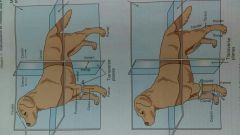
A plane across the body that divides it into cranial and caudal parts that are not necessarily equal. |
|
|
|
Sagittal planes |
A plane that runs the length of the body and divides it into left and right parts that are not necessarily equal halves. |
|
|
|
Median plane |
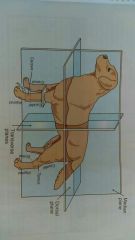
Sagittal plane that runs down the center of the body lengthwise and divides it into equal left and right halves. |
|
|
|
Dorsal plane |
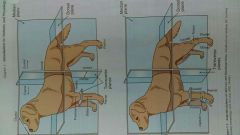
A plane at right angles to the sagittal and transverse planes. It divides the body into dorsal and ventral parts that are not necessarily equal. |
|
|
|
Cranial |
Toward the head end of the body. |
|
|
|
Caudal |
Towards the tail end of the body. |
|
|
|
Rostral |
Towards the tip of the nose. |
|
|
|
Dorsal |
Toward the back. |
|
|
|
Ventral |
Toward the belly. |
|
|
|
Medial |
Toward the median plane. |
|
|
|
Lateral |
Away from the median plane. |
|
|
|
Deep |
Toward the center - whole body or part. |
|
|
|
Superficial |
Toward the surface - whole body or part. |
|
|
|
Proximal |
Toward the body. |
|
|
|
Distal |
Away from the body. |
|
|
|
Palmar |
Bottom of front foot. |
|
|
|
Plantar |
Bottom of hind foot. |
|
|
|
How does each of the anatomical planes of reference divide a cow's body? (Sagittal, median, transverse, and dorsal.) |
The sagittal planes divide a cow's body from nose to hind. The median plane is the most central sagittal plane, running the length of the cow's body in two equal halves - left and right. The transverse planes divide the cow's body into front and back sections at a 90° angle to the median plane. The dorsal plane divides the cow's body into top and bottom sections, where the cow's back is dorsal and the belly is ventral. |
|
|
|
Which surface of a hamster's front leg is in contact with the ground when it is walking normally? What surface of the hind leg? |
Palmar and plantar, respectively. |
|
|
|
Bilateral symmetry |
The left and right halves mirror each other. |
|
|
|
Dorsal body cavity |
Contains the brain, brain stem, and spinal cord. Consists of two parts: a semi-spherical cranial cavity and a long narrow spinal cavity. |
|
|
|
Cranial cavity |
Part of the dorsal body cavity, also known as the cranium. Formed by the skull. |
|
|
|
Spinal cavity |
Part of the dorsal cavity, known as the spinal canal. Formed by the vertebrae. |
|
|
|
Ventral body cavity |
Contains viscera (soft organs) and divided into two parts by the diaphragm - the thorax and the abdomen. |
|
|
|
Thoracic cavity |
One part of the ventral body cavity, cranial to the diaphragm. Contains the heart, lungs, esophagus, and many major blood vessels. All organs are covered with pleura - visceral pleura coats the organs themselves, the parietal layer lines the cavity. |
|
|
|
Abdominal cavity |
Ventral body cavity caudal to the diaphragm. Contains the digestive, urinary, and reproductive organs, which are coated with a thin membrane called peritoneum (which also lines the cavity itself). |
|
|
|
Pleura |
Thin membrane that coats the thoracic organs and lines the inside of the thoracic cavity. |
|
|
|
Peritoneum |
Thin membrane that coats the organs of the abdominal cavity and lines the abdominal cavity. |
|
|
|
According to the principle of bilateral symmetry, single structures in the body are located on or near which anatomical plane of reference? |
The medial plane. |
|
|
|
What are the four types of tissues? |
Epithelial, connective, muscle, and nervous. |
|
|
|
Epithelial tissue |
Composed entirely of cells, it's main function is to cover body surfaces. It also forms glands. |
|
|
|
Connective tissue |
Holds the body together. Ranges from very soft (adipose) to very firm (bone). Composed of cells and a variety of nonliving intracellular substances such as fibers. |
|
|
|
Muscular tissue |
Moves the body internally and externally. Comprised of three types: cardiac, skeletal, and smooth. |
|
|
|
What are the three types of muscle tissue? |
Cardiac, skeletal, and smooth. |
|
|
|
Skeletal muscle |
Moves the bones of the skeleton, most often under conscious nervous system control. |
|
|
|
Cardiac muscle |
Makes up the heart and operates without conscious nervous system control. |
|
|
|
Smooth muscle |
Found in internal organs such as the urinary bladder and digestive tract and operates without conscious nervous system control. |
|
|
|
Nervous tissue |
Transmits information around the body and controls body functions. |
|
|
|
Organs |
Made up of groups of tissues that work together for a common purpose. |
|
|
|
Systems |
The most complex level of body organization, systems are groups of organs that are involved in a common set of activities. |
|
|
|
Homeostasis |
The maintenance of a dynamic equilibrium in the body. |
|
|
|
How does the normal anatomy and physiology of cells in an animal's body impact the health of the animal as a whole? How does the normal anatomy and physiology of the animal's body as a whole impact the health of the cells? |
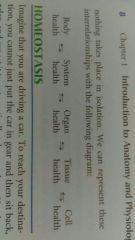
|
|
|
|
How do homeostatic mechanisms influence the health of the animal? |
By maintaining optimal conditions for health - such as proper oxygen, pH, temperature, hydration, and nutrition - cellular health and thusly overall health is best managed. |
|
|
|
Matter |
Anything that has mass and takes up space. |
|
|
|
Element |
Cannot be divided into another substance by ordinary chemical processes. |
|
|
|
Which are the most common elements in a living animal? |
Oxygen, carbon, hydrogen, and nitrogen. Minor elements also include calcium, phosphorus, potassium, sulfur, sodium, chlorine, and magnesium. |
|
|
|
Atom |
Smallest unit of an element that retains the unique properties of that element. Comprised of negatively charged particles called electrons, positively charged particles called protons, and neutral particles called neutrons. |
|
|
|
Atomic weight |
The collective number of neutrons and protons in an element's atomic nucleus. |
|
|
|
Atomic number |
Collective number of protons in an element's atomic nucleus. |
|
|
|
Ion |
An atom with either more or fewer electrons than usual, giving it either a negative or positive charge respectively. |
|
|
|
Isotope |
An atom with either more or fewer neutrons than usual. |
|
|
|
Compound |
A molecule with atoms of different elements. |
|
|
|
Molecule |
More than one atom joined together. |
|
|
|
Covalent bond |
A bond formed when atoms share electrons. |
|
|
|
Chemical bond |
The way that atoms join together to form molecules. |
|
|
|
Ionic bond |
A bond formed when electrons are transferred from one atom to another. When this occurs, the donor atom becomes positively charged and the recipient becomes negatively charged, resulting in electrostatic attraction. |
|
|
|
Cation |
Positively charged ion. |
|
|
|
Anion |
Negatively charged ion. |
|
|
|
Hydrogen bond |
A specific type of weak chemical bond between hydrogen atoms already covalently bonded in a molecule to oppositely charged particles. This occurs mostly between molecules. |
|
|
|
Chemical reaction |
Formation and destruction of chemical bonds. |
|
|
|
Activation energy |
The energy required for a reaction to occur. |
|
|
|
Catalyst |
A type of molecule that starts out speeds up a chemical reaction. |
|
|
|
Enzymes |
Special catalysts that are not used up in a chemical reaction. Generally used in digestion. |
|
|
|
What are the four properties of water that make it so necessary for life? |
Water is a universal solvent. Water is an ideal transport medium. Water has a high heat capacity and a high heat of vaporization. Water is used for lubrication. |
|
|
|
Electrolytes |
Substances that have the ability to transmit an electrical charge. |
|
|
|
What is the pH scale? |

|
|
|
|
What does pH measure? |
Concentration of H+ ions (acidic) and OH- ions (basic). |
|
|
|
Buffer |
A substance that limits the accumulation of excessive hydrogen or hydroxyl ions. |
|
|
|
Carbohydrates |
Used for energy, storage of energy, and cellular structure. Examples include: monosaccharides, disaccharides, polysaccharides, and glucose. |
|
|
|
Hydrolysis |
The use of water to break down carbohydrates. A form of catabolism. |
|
|
|
Dehydration synthesis |
Removal of water to build a molecule. A form of anabolism. |
|
|
|
Glucose formula |
C6H12O6 |
|
|
|
What the elements are found in all carbohydrates? |
Carbon, oxygen, and hydrogen. |
|
|
|
Lipid |
Used in the body for energy, and are stored in fat for further energy needs. Some serve as messengers in the form of hormones. There are four classifications of lipids: neutral fats, phospholipids, steroids, and eicosanoids. |
|
|
|
Neutral fats |
Triglycerides or fats. Contains three fatty acids and a glycerol molecule (modified sugar). Hydrophobic. |
|
|
|
Phospholipids |
Much like triglycerides, they have a glycerol backbone and two fatty acids, but in place of the third fatty acid there is a phosphate group. Hydrophilic and polar, this allows the molecules to line up and form a bilayer. |
|
|
|
Steroids |
Lipids that take the form of four interlocking hydrocarbon rings. Hydrophobic, non-polar, and differentiated by attaching unique functional groups. |
|
|
|
Eicosanoids |
Lipids formed from a twenty-carbon fatty acid and ring structure. Meditate certain chemical processes and include prostaglandins, thromboxane, and leukotrienes. |
|
|
|
Protiens |
The most abundant organic molecule in the body. Used for cell structures and structural body tissues, controlling chemical reactions, regulating growth, and immunity. Also act as catalysts and facilitate metabolic processes. |
|
|
|
Amino acids |
There are twenty forms used by the body. Contains a central carbon atom attached to a hydrogen atom, an amino group, a carboxyl group, and a "side chain". Carboxyls link via peptide bonds. |
|
|
|
Nucleic acids |
Largest molecules of the body. DNA and RNA. Comprised of nucleotides. |
|
|
|
Cell |
Basic unit of living things. Can exist alone as a single organism or can combine with other cells to form more complex organisms. |
|
|
|
What governs a cell's development, metabolism, and specialization? |
Generic material, or DNA. |
|
|
|
Prokaryotes |
Single-celled organisms that do not possess a nucleus. ("Pro-" meaning "before" and "karyote" meaning "nucleus".) |
|
|
|
Eukaryotes |
Cells characterized by a distinct nucleus. ("Eu-" meaning "true" and "karyote" meaning "nucleus".) |
|
|
|
Why is cell size limited? |
Size is limited by two factors: surface area ratio (a large cell with a small surface area would not be able to properly distribute nutrients before starving), and governing capability of the nucleus (a single nucleus had better control of a small cell). |
There are two reasons! |
|
|
What structures can be found in all animal cells? |
A cell membrane, cytoplasm, a nucleus, and organelles (such as mitochondria). |
|
|
|
What structures can be found in all animal cells? |
A cell membrane, cytoplasm, a nucleus, and organelles (such as mitochondria). |
|
|
|
Cell membrane |
A flexible, elastic barrier comprised of a phospholipid bilayer and peripheral proteins which serves as a boundary between extracellular and intracellular compartments and controls the passage of substances into and out of a cell. |
|
|
|
Cytosol |
The fluid of a cell. |
|
|
|
Mitochondria |
The powerhouse of the cell, produces 95% of the energy that fuels the cell. |
|
|
|
Ribosomes |
Comprised of two subunits and containing ribosomal RNA, these create and assemble proteins for cellular use. |
|
|
|
Endoplasmic Reticulum |
Or "ER", comes in smooth and rough forms. The rough form has ribosomes on its surface and is involved in protein production. The smooth ER is active in the synthesis and storage of lipids. |
|
|
|
Golgi Apparatus |
Found near the nucleus, modifies and packages proteins from the rough ER for delivery throughout the cell. |
|
|
|
Lysosomes |
Special vesicles formed by the golgi apparatus, contains enzymes designed to break down nutrient molecules. |
|
|
|
Nucleus |
The control center of the cell, lines by a nuclear envelope and containing chromatin - the raw DNA of the cell. |
|
|
|
Hypertonic |
More concentrated than the cytoplasm. |
|
|
|
Hypotonic |
Less concentrated than the cytoplasm. |
|
|
|
Isotonic |
Equilibrium, equal to the concentration of the cytoplasm. |
|
|
|
What are the stages of cell division? |
Interphase and the Miotic phase. |
|
|
|
Interphase |
G1, S, and G2. Can last a very long time. |
|
|
|
Mitosis |
Prophase, metaphase, anaphase, telophase, and cytokenisis. |
|
|
|
Prophase |
Chromatin condenses into chromosomes, comprised of two identical chromatids linked together at the center (kinetochore or centromere). |
|
|
|
Metaphase |
Chromosomes line up along the metaphase plate. |
|
|
|
Anaphase |
The chromosomes split apart and are drawn towards the opposed centrioles. |
|
|
|
Telophase |
Chromosomes unravel and are repackaged into a new nucleus. |
|
|
|
Histology |
Microanatomy, the study of the microscopic structures of tissues and organs. |
|
|
|
What are the six functions of epithelial tissue? |
Protection, filtration, absorption, sensory input, secretion, and excretion. |
|
|
|
What are the junction types between epithelial cells? |
Tight, gap, and desmosome. A tight junction holds cells together with proteins. A gap junction has holes in it to allow communication between cells. And a desmosome is held together with intracellular filaments. |
|
|
|
Basement membrane |
A nonliving network of fibers on which epithelial cells are cemented. |
|
|
|
Squamous epithelia |
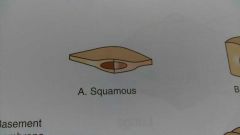
Delicate and thin, flat and smooth. |
|
|
|
Cuboidal epithelia |
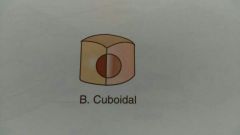
Square, often excretory. |
|
|
|
Columnar epithelia |
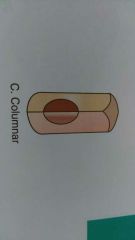
Elongated and closely packed, thicker than simple forms of other epithelium. Nuclei are not centrally located, but usually aligned toward the basement membrane. |
|
|
|
Stratified epithelium |
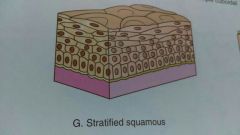
Multi layered. |
|
|
|
Pseudostratified epithelium |

Not truly stratified, but has the appearance as the nuclei are found at multiple levels of the tissue layer. |
|
|
|
Transitional epithelium |
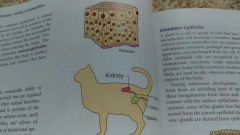
May change in appearance as the need arises, usually in organs that stretch such as the bladder. |
|
|
|
What is the difference between exocrine and endocrine glands? |
Endocrine glands do not have ducts and release their contents directly into the bloodstream or throughout the body. Exocrine glands act locally. |
|
|
|
Merocrine gland |

Secrete via exocytosis, packaging their sections and releasing them. |
|
|
|
Apocrine gland |

Secretes by cytokenisis, losing the top portion of the cell completely. |
|

